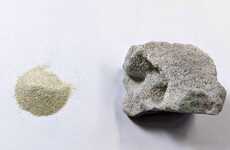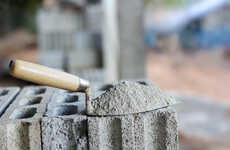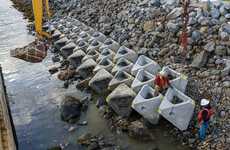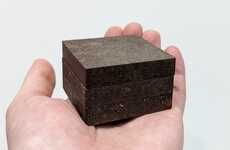
Researchers Develop Self-Healing Concrete
Michael Plishka — May 6, 2009 — Art & Design
References: impactlab & news.nationalgeographic
The human body is an amazing piece of engineering. Cut your skin, and the body recognizes the cut and starts a series of reactions that closes off the injury and heals the wound.
Taking a cue from the the body, researchers at the University of Michigan have developed concrete that also heals itself with chemical elegance.
Concrete cracks because, while it is very strong under compression, it does not do well under tension or flexing--it cracks and breaks.
This concrete is more flexible, however, due to its chemical makeup and as a result is well suited for use in highways, bridges and buildings where bending and flexing causes cracks.
With this concrete, even if it does micro-crack, exposure to a light rain shower causes the concrete to heal and the resulting concrete is as strong as the uncracked material.
Taking a cue from the the body, researchers at the University of Michigan have developed concrete that also heals itself with chemical elegance.
Concrete cracks because, while it is very strong under compression, it does not do well under tension or flexing--it cracks and breaks.
This concrete is more flexible, however, due to its chemical makeup and as a result is well suited for use in highways, bridges and buildings where bending and flexing causes cracks.
With this concrete, even if it does micro-crack, exposure to a light rain shower causes the concrete to heal and the resulting concrete is as strong as the uncracked material.
Trend Themes
1. Self-healing Materials - The development of flexible self-healing concrete can lead to the creation of self-healing materials that can repair themselves when damaged.
2. Sustainable Construction - The use of flexible self-healing concrete can revolutionize the construction industry by reducing the maintenance cost of industrial constructions like highways, bridges, and buildings, making them more sustainable.
3. Advanced Civil Engineering - The use of high-tech materials like flexible self-healing concrete by civil engineers can lead to the development of more advanced structures and infrastructures that can self-repair, improving both safety and long-term performance.
Industry Implications
1. Civil Engineering - Civil engineering can benefit from using flexible self-healing concrete for construction of highways, bridges, and buildings, leading to more secure and cost-effective infrastructures.
2. Construction Materials - Construction material manufacturers can introduce new products that incorporate self-healing properties to their product lines, creating a new market segment for their products in the construction industry.
3. Environmental Technology - Environmental technology industries can benefit from the adoption of self-healing materials, such as flexible self-healing concrete, because it contributes to sustainable practices in the construction industry through reduced maintenance and repair.
2.1
Score
Popularity
Activity
Freshness























